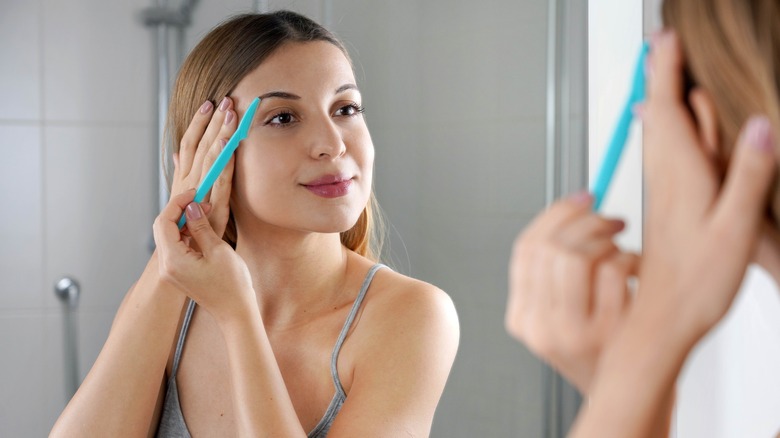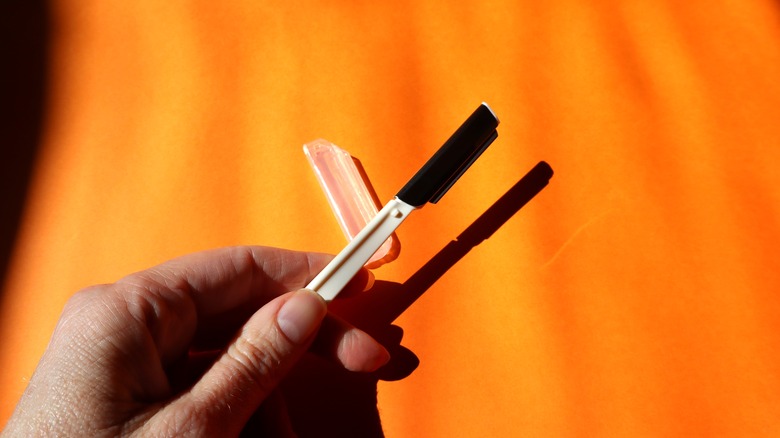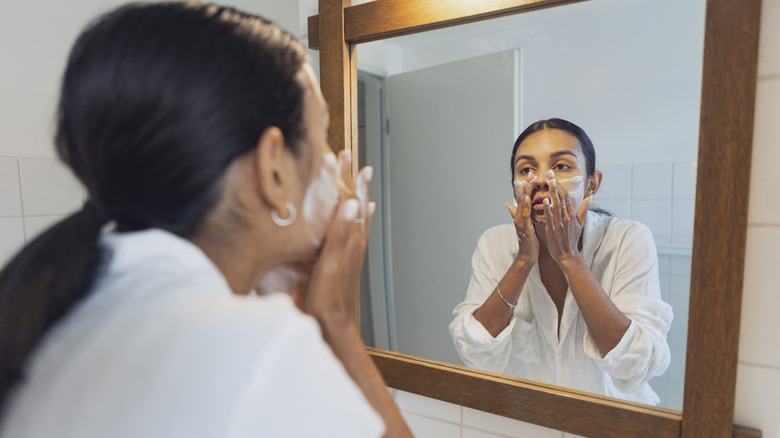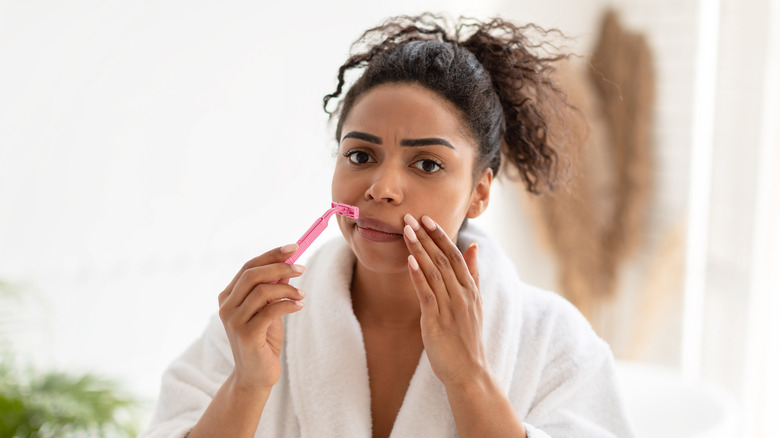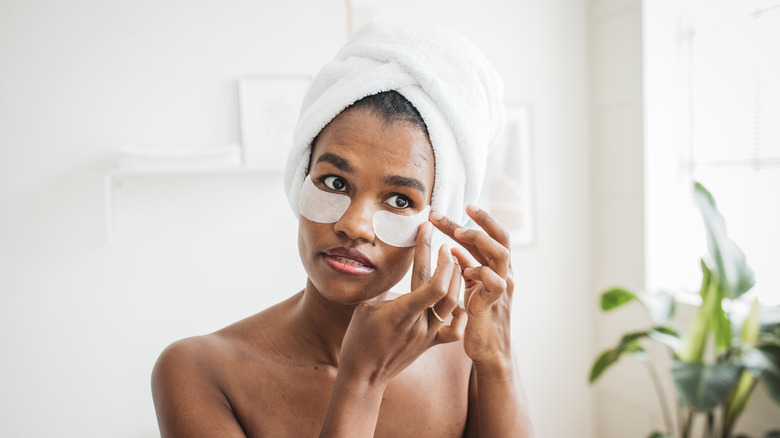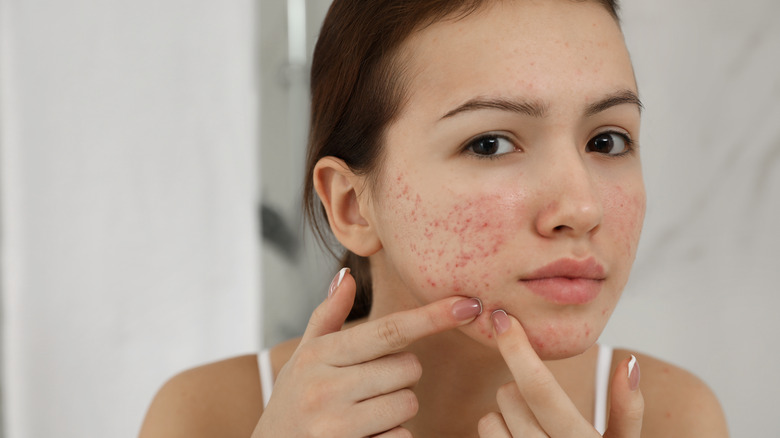5 Tips To Help You Safely DIY A Dermaplaning Treatment
If you struggle with unwanted facial hair that appears coarse, dark, or just a little too fuzzy for your liking, you aren't alone. While facial hair is perfectly natural, some people (usually women) can become rather self-conscious of their peach fuzz. Whether you take regular trips to the salon for a facial wax or you've tried just about every at-home hair removal cream on the shelves, it can feel like a never-ending struggle to keep your facial hair at bay. If this sounds like you, dermaplaning may be the answer.
Dermaplaning is the process of removing the outermost layer of skin with a scalpel-like razor, taking with it any dirt, oil, and hair that is hanging out on the surface of your face. While many estheticians and facialists offer a professional dermaplaning service, the process is so simple, you can do it yourself at home! Dermatologist Audrey Kunin explained to Byrdie that where you perform the treatment isn't as important as what tool you use, saying, "Dermaplaning is similar to shaving, however the tool is better suited to exfoliate the epidermis than a razor." Per the expert, the best tools to use are marketed as facial razors or eyebrow shapers. You have probably seen them hanging out around the beauty aisle — they look sort of like toothbrushes with a tiny blade along the side rather than bristles. For those looking to save a few bucks while saying goodbye to your pesky facial hair, say hello to at-home dermaplaning.
Regular dermaplaning can provide some serious benefits
Rest assured that shaving your face via dermaplaning will not create thicker, darker, or coarser hair upon regrowth. This is a long misunderstood stereotype that many skin experts answer over and over again — facialist Dr. David Jack debunked the hair regrowth myth, telling PopSugar, "There is no scientific basis for this. A surgical blade is used, which just shaves the ends from the fine vellus hairs. Nothing happens to the follicles themselves, so the growth of the hair isn't changed."
When you do decide to try dermaplaning, you may see some welcomed benefits along with hair removal: your skin's texture may become smoother, more even, and more luminous, according to Medical News Today. The process can also help reduce oil buildup and the appearance of acne scars. When the soft layer of hair is removed from your face, you may also notice that your skincare routine is more effective and your makeup can be applied more smoothly. The biggest benefit that a majority of users find is a boost in self-confidence after tackling their unwanted facial hair.
Prep your skin for the dermaplaning process
When you are preparing to dermaplane in the privacy of your own bathroom, the most important first step is to thoroughly cleanse your face. Make sure that you have removed all makeup, dirt, and oil before attempting to use your facial razor. Aesthetician Karina Sulzer told WhoWhatWear that a gentle cleanser is ideal, as you will exfoliate your skin plenty when you begin dermaplaning.
It is also very important that you dry your face thoroughly — it may feel a tad unpleasant to hold off on the serums and moisturizer after washing your face, but dermaplaning with any lingering dampness can jeopardize the effectiveness of the treatment. Dermaplaning with a dry face is also the safest way to proceed, letting your facial razor easily catch any dead skin cells, hair, and other buildup without the risk of nicking you. Make sure all of your dermaplaning tools are also clean and dry, and avoid using water to wipe away any debris during the dermaplaning process; instead opt for a clean, dry cloth or cotton pad.
Make sure you're headed in the right direction while using your facial razor
Before you start hacking away at your peach fuzz, it's important to map out a specific shaving pattern. Esthetician Kerry Benjamin revealed the ideal step-by-step guide for DIY dermaplaning to Byrdie. First, the expert advises "[pulling] the skin taut" with one hand at the base of your ear, allowing the skin to be tight and easily shaved without being cut. Move the facial shaving tool "downwards in short strokes with the razor at a 45-degree angle" for the most accurate results. Repeat this shaving process along your jaw, down your cheek, jaw, chin, and lip area, carefully moving your tool further down each time. If other areas of your face such as your forehead or neck need additional attention, continue shaving in a short, downward motion until you have covered the entire surface of your face. Try your best to maintain only a slight pressure and take your time during the process.
Be careful not to go over your skin again after shaving; you don't want to remove more than the outermost layer of skin. In fact, many skin experts warn against dermaplaning more than once or twice a month. If you feel like you want more exfoliation, you can follow up with an exfoliating cleanser. Benjamin does warn newbies to hold off on extra exfoliation: additional exfoliates can cause serious irritation if your skin is still getting used to facial shaving.
Don't skip out on the rest of your skincare routine
After you've cleansed, dried, and properly dermaplaned your face, don't forget the remainder of your skincare routine. Dermaplaning leaves the surface of your skin smooth and hairless, but it is also very vulnerable. Karina Sulzer explains that hydration is the goal post-dermaplaning. After you are done with your facial razor, Sulzer advises reaching for your favorite "products with hyaluronic acid or soothing gel masks to supply even more nourishment," per WhoWhatWear.
Cosmetic dermatologist Dr. Apratim Goel told Vogue India that it is normal to feel slightly sensitive after dermaplaning, especially when you are first starting out. The expert recommends "[Using] a calamine moisturizer or a mild antibiotic lotion and do not use any strong skincare ingredients such as retinol or glycolic acid. Finish with sunscreen." If you haven't tried the viral skin cycling trend, we recommend checking it out. The process allows you to schedule different portions of your skincare on different days to avoid layering competing products and avoid irritating your skin with too many treatments at once. No matter what today's skincare calls for, always cleanse, tone, and moisturize, finishing with SPF protection for good measure!
Dermaplaning isn't for everybody
Using a facial razor can result in smoother skin, but not all skin types appreciate the harsh treatment. Unfortunately for people with extremely sensitive skin, dermaplaning may be another thing to add to your list of skincare treatments to avoid. While dermaplaning can provide serious benefits for those with occasional peach fuzz and excessive oils, skin that is highly prone to irritation can cause other skincare issues to flare up, such as rosacea and cystic acne. Speaking of which, dermaplaning is definitely not safe for those with large blemishes. If you do find a blemish while using your facial razor, avoid shaving over your blemish, as this can make it worse and potentially cause it to scar. Those with allergies to metal may also want to avoid over-the-counter facial razors, as many of them contain stainless steel that can cause allergic reactions in those with sensitive skin.
Even those with historically tolerant skin should proceed with caution when deciding to dermaplane at home. If you find that you are experiencing abnormal skin sensitivity, an increase in breakouts, or notice scarring, stop dermaplaning right away. If you use a tool that is not cleaned or is old and has developed rust, you also increase your risk of getting an infection. Dermaplaning at home can be done with ease, but ensure that you are practicing safely with clean tools and the proper understanding of your skin's tolerance before starting.
